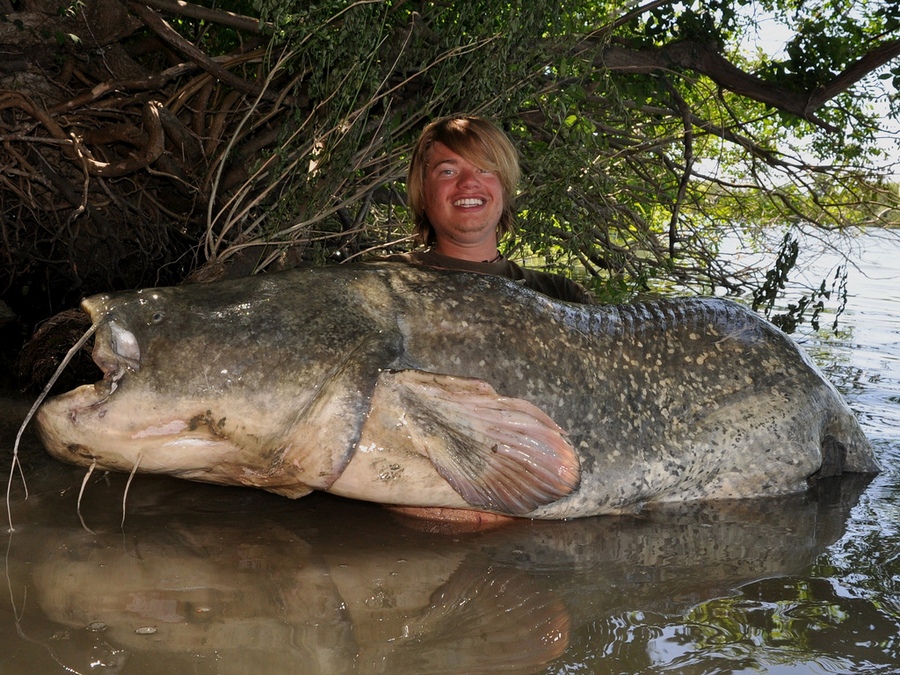Varieties of river fish. The largest freshwater fish in the world
As soon as large fish were discovered in the oceans and seas, people began to fear them. Everyone was afraid of how the big freshwater inhabitants satisfy their hunger. After all, the larger a fish, the more food she needs to eat. Therefore, in order to satisfy the needs of their growing organism for food, freshwater giants begin to eat their smaller relatives. different types. Typically, fish are classified according to features such as genus, species, and the like. We tried to do it based on their size. Here is the list of top 10 The biggest freshwater fish in the world.
Taimen is a large fish from the salmon family, so it is often called nothing more than “Russian salmon”. Its habitat is large rivers and lakes of Siberia, Far East and Altai. The predator is able to reach 1 m or more in length and up to 55-60 kg in weight. This species is famous for its aggressive and merciless character. It is believed that the taimen is able to feed on its own cubs. There are no food restrictions for this freshwater species. Russian salmon eats literally everything that comes in its way.
catfish

Catfish is a large freshwater scaleless fish. It lives in lakes, rivers of the European part of Russia, as well as in Europe and the Aral Sea basin. V good conditions this species grows up to 5 m in length and at the same time gains weight up to 300-400 kg. Despite their large size, the body of catfish is extremely flexible. This allows an active nocturnal predator to quickly get their own food. There is a misconception that this species feeds only on carrion or spoiled food. But it's not. In fact, the main food for catfish are fry, small crustaceans and aquatic insects. And then, such a diet in freshwater fish is only at an early stage of development. Later, it is replenished with live fish, various shellfish and other freshwater animals. There are even cases when the largest catfish attacked small domestic animals and waterfowl.

You can meet the Nile perch in the rivers, lakes and ponds of tropical Africa. It is especially common in the Ethiopian region. The body of a restive predator reaches a length of 1-2 meters and a weight of 200 or more kg. The Nile perch eats crustaceans and various types of fish.
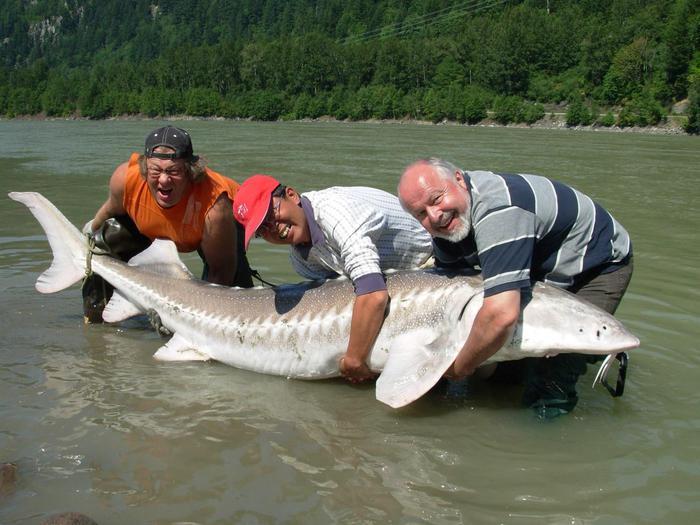
Beluga belongs to the sturgeon family. This large fish lives in the depths of the Azov, Black and Caspian seas. Beluga can reach a whole ton in weight. At the same time, its body length will be more than 4 meters. Real long-livers belong to this species. The predator can live up to 100 years. In food, the beluga prefers such types of fish as herring, gobies, sprat, etc. Also, the fish likes to eat shellfish, and sometimes it hunts seal cubs - pups.

The white sturgeon is the largest fish found in North America and is ranked sixth in our ranking. biggest fish in the world. It is widespread in fresh waters from the Aleutian Islands to central California. The predator grows up to 6 m in length and can gain weight of 800 kg. This kind big fish extremely aggressive. Mostly white sturgeon lives at the bottom. The predator feeds on mollusks, worms, and fish.

The paddlefish is a huge freshwater fish that lives primarily in the Mississippi River. It is also possible to meet representatives of this species in a number of large rivers that flow into the Gulf of Mexico. The predatory paddlefish does not pose a threat to humans. However, he likes to feed on individuals of his own species or other fish. And yet most of those who belong to this species are herbivores. They prefer to eat only herbs and plants that usually grow in the depths of fresh water. The maximum recorded body length of a paddlefish is 221 cm. The most big fish can gain weight up to 90 kg. The average life expectancy of a paddlefish is 55 years.

Carp is a very large omnivorous fish. This species lives in almost all freshwater rates, reservoirs, rivers and lakes. At the same time, carp prefers to populate quiet, stagnant waters with a hard clay and slightly silted bottom. It is believed that the largest individuals live in Thailand. Carp can reach a weight of more than one hundred kilograms. Typically, fish of this species live for about 15-20 years. The carp's diet includes small fish. Also, predators like to feast on caviar of other fish, crustaceans, worms, insect larvae. While hunting, it is common for this species to kill a large number of small fish, because carp needs food all the time, as it belongs to such fish as stomachless.
stingray

Third place on our list of ten most largest freshwater fish in the world occupies a ramp. The stingray is a beautiful predatory fish that can be found both in tropical seas, in the waters of the Arctic and Antarctica, as well as in fresh water. Most of all fish of this species are common in Asia. Inhabit slopes and shallow water, and depth. The most gigantic individuals reach up to 7-8 m in length. In this case, the slope can gain weight up to 600 kg. Large fish feed mainly on echinoderms, crayfish, mollusks and small fish.
Giant mekong catfish
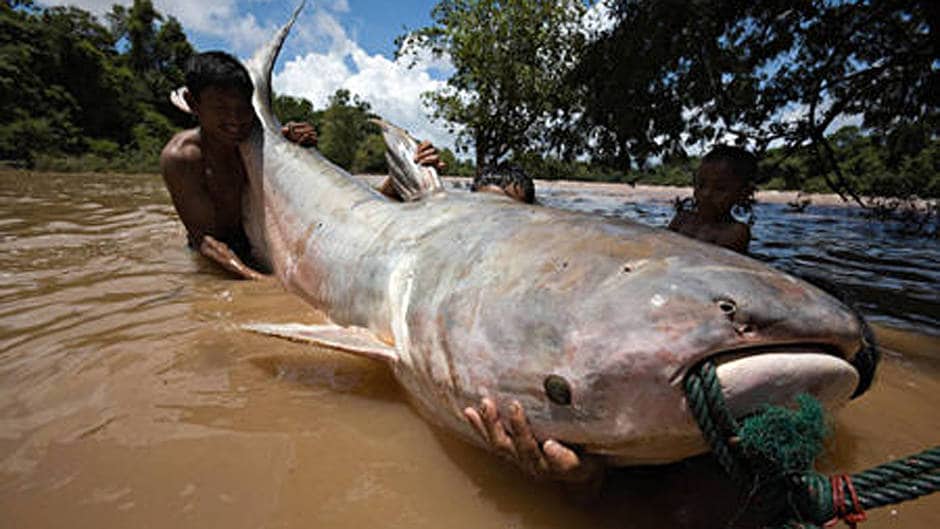
The giant Mekong catfish lives in the fresh waters of Thailand. It is considered the largest member of its species and therefore is often considered and studied separately from its congeners. The body width of the giant Mekong catfish sometimes reaches more than 2.5 m. Maximum weight this type of fish - 600 kg. Giant Mekong catfish feed on live fish and small freshwater animals.
Alligator Gar

Catfish
The largest freshwater fish or river monsters did not deprive Russian freshwater reservoirs of their presence, which include large rivers and reservoirs. And a conditional pedestal in the hierarchical table of such giant fish is headed, of course, by catfish.
The largest specimens of catfish, of course, are real monsters that attack all living things, sometimes not disdaining carrion, although mostly catfish are real predators and hunters attacking fish, small animals and birds. Willingly eats catfish and frogs. Apparently, the cases of feeding these fish with drowned animals and dead fish are mostly associated with seasonal or climatic disruptions, which have recently been frequent and violate the usual weather conditions. And this, in turn, affects the timing of fish breeding and other underwater laws, which often creates poor conditions for catfish fattening. In addition, bilge water discharges and runoff from enterprises kill underwater fauna, which negatively affects the reproduction and life of mollusks. And catfish very willingly eat various bivalve mollusks like toothless and barley.

The largest fish in Russia - catfish - have terrible strength, impressive size and greed, which often borders on recklessness. In the literature, cases of attacks of catfish even on humans were described, which served to create legends and literary works, where the hunting of catfish for children who were on rafts where their mothers washed clothes was described rather harshly and with dreary-monstrous realism. As if catfish licked children from rafts. Then there was a merciless hunt for these monsters. Children were found or not found in the stomachs of predators, but all large fish were destroyed without exception. There are descriptions, it seems, in V.K. Arsentiev, cases of attacks by huge catfish on bears catching fish in the shallows. This seemingly fairy tale, meanwhile, could well have taken place, given the size of the catfish and its strength in its natural environment, while a bear, even the strongest, loses its advantage in water, especially if the river has a strong current. Cases are also described when a catfish tried to drag an adult under water by grabbing his leg. It was a villager and in his hands was, fortunately, a sickle, with which he fought off the catfish. And many such cases have been described, however, such attacks of predators date back to earlier centuries of Russian history, when catfish reached a weight of 400 kilograms and a size of up to 5 meters. Large Russian catfish are quite suitable for the category - the largest river fish in the world.
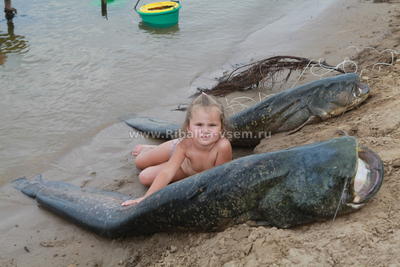
But in our time, catfish weighing 30 kilograms are considered large prey, and specimens weighing 50-100 kilograms are already called trophy fish. And such fish come across not so often, if not rarely. Even more rare are catfish weighing more than 200-250 kg, but, according to rangers, such fish are still found in the Volga waters. In Russia, the places of catching trophy catfish are the deep channels and eriki of the Lower Volga, as well as the main Volga channel with deep, stubby pits and steep bottom reliefs.
There is something mystical in the appearance of this large scaleless fish with a large head and a huge mouth, where numerous sharp teeth in the form of a brush are visible. Two long whiskers flutter in the water above the mouth, and four more antennae are visible under the lower jaw. And among this powerful composition of the appearance of an underwater monster, small eyes look somehow ridiculous ... At first glance, it seems that these eyes are kind, as in fairy tales with the mention of "Somovichi" and other characters. But this is only at first glance. In the eyes of the catfish lurks a merciless rage. The head of the catfish is the main and most a large part fish figures. Everything else is occupied by a long tail, a stretch, wriggling like a snake, and sometimes a white marble belly. The back of the catfish casts blued steel.
Photos of the largest river fish often show catfish. And this is connected, most likely, with the same question, do real cannibal catfish exist in reality? These huge fish are too mysterious and there are so many tales about them. But still there is evidence of catfish attacks on people in our time, given that giant individuals are still found. According to a specialist in zoology from the United States, David Wheeler, there are catfish weighing half a ton and measuring more than six meters. Such facts are given in his book about catfish of unprecedented size, still living in large bodies of water.
And in our time, there are catfish attacks on animals, the victims of which are usually pets and young cows, sheep, goats, as well as adults. People also became targets of attacks by underwater predators, and most often they were children. In the middle of the summer of 1982, researchers and rangers of the Khopersky Reserve witnessed a catfish attack on a young deer and his death when a huge fish pulled him under water. Bears swimming across the river also became victims of catfish. This is still being told in the Siberian region.

So, the largest freshwater fish is catfish? Among other things, and a cannibal? Quite possible. Here are some more facts, moreover, from very recent history. It happened in the Voronezh region at the end summer season, in the 90s. Near the village of Kulakovo, a boy and a woman became victims of an attack by a huge killer catfish. They bathed in the evening in the hunting grounds of cannibal catfish.
Similar cases of people disappearing in the evening have been reported in China at a large reservoir. People went to swim and did not return from the water. The mystery of their disappearances was solved when a giant catfish, three meters in size, was caught with human remains in its stomach. One head of this catfish was a meter in size.

True or not, it is difficult to judge, but according to some sources, a five-meter catfish was found in a tugboat that sunk on the river on board the ship, punching a hole in the hull. In the stomach of the monster, the remains of three Polish tourists were found, who, after the disaster with a tugboat, moved to a small rescue ship, but never made it to the shore. It was on the Dnieper.
Beluga
The list, which includes the largest freshwater fish or river monsters, should also include the beluga. It would, of course, be in first place in terms of size among Russian fish. But this huge fish does not belong to the permanent and typical river inhabitant, since it is an anadromous species of fish and enters the rivers only for spawning. Meanwhile, in the local history museum of the Republic of Mari El, among the exhibits there is a beluga weighing a ton, once caught in the Volga. But this is not the limit of the weight and size of the beluga. According to unspecified and unofficial data, not so long ago there were individuals weighing up to 2 tons and up to 7-8 meters long. Confirmed data indicate the capture of the largest specimen of this fish weighing one and a half tons and 4.2 meters long. Some of the largest beluga are real centenarians, as they can be 100 years old.
The largest river fish in Russia, although they do not constantly live in rivers, nevertheless, spend a very large part of their lives there. This is due to the characteristics of reproduction. Being inhabitants of the Caspian, Black, Azov and, according to some reports, the Adriatic seas, beluga go to spawn mostly in the Volga, as well as in the rivers: Ural, Terek and Kura. But if earlier these powerful and ancient fossil fish rose quite high along the Volga, to the middle reaches and higher, then with the emergence of the Volga cascade of dams and hydroelectric stations, the rise of the beluga stopped, at least to the previous levels.
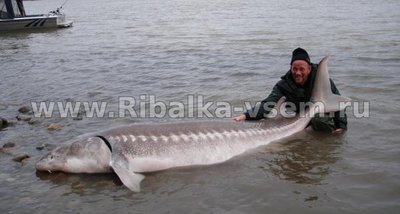
Fish passage facilities did not help either. In addition, at some dams they either did not exist at all or they did not work at full capacity. For example, at the Cheboksary hydroelectric power station in the early years, instead of fish passage facilities, only an 8 cm grate was installed, on which the passing large fish were cut and died, falling to the bottom under the discharge of water from the dam.
The largest river fish in the world hardly reached the size of the Russian beluga, at least those individuals that entered our rivers in the 18th and 19th centuries. Meanwhile, in our time, these valuable sturgeon fish, which once supplied a lot tasty meat and gourmet black caviar, are on the verge of extinction, despite the prohibitions. And in the good old days, even a simple peasant could afford to taste deli meat beluga and the same delicious black caviar, moreover, in large quantities. So it happened one fine day in the year 1891, when a strong wind from the shore unexpectedly and quickly drove water from the Gulf of the Sea of \u200b\u200bAzov near Taganrog. In a shallow bay, in a puddle, this lucky man found a beluga weighing 20 pounds (327 kg). There were almost 50 kilograms of black caviar in it. This is where you can eat real fish and black caviar at least a tablespoon, simply! ..
Siberian taimen
The largest freshwater fish in Russia are also found in Siberian rivers. And the largest and most beautiful predator ice waters is the taimen. This is the oldest fish of all salmon, since taimen lived about 18 million years ago. Most species and subspecies of taimen, including lenok and char, are predominantly freshwater, with the exception of the Sakhalin taimen, which at certain times adheres to the mouths of rivers and the desalinated part of the sea.

In our country, taimen live in the rivers of Siberia, as well as in the rivers of the Amur basin. These powerful and incredibly beautiful fish are the object of sport fishing on the principle of “catch and release”. This strict principle is a vital necessity, since the Siberian taimen is already an endangered fish species.
Among the fish of Russia, taimen are distinguished by their size and weight. The largest specimens reached not so long ago the weight of a centner and a length of two meters and a hook. Since 1993, the record has been held for the largest taimen caught on sports tackle and released back into the waters of the river. The weight of this trophy fish was 41.95 kg. However, no, no, and the information will pass, they say, they caught somewhere in a mountain river a taimen weighing 50 kg, or even all 80 kilograms. In a word, taimen is the largest freshwater fish in our country beyond the Ural ridge.
Taimen are real predators capable of swallowing large fish. Outwardly, this large fish is a living torpedo, for which a strong current and rapids of mountain rivers are not an obstacle. The usual coloring of the taimen consists of brown tones on the back and silver on the sides with dark spots. During the mating season, these fish become even more beautiful. Visibility and brightness are given to them by red, almost orange ventral fins, as well as juicy red with a copper tint - anal and caudal fins.
The element of taimen is icy mountain rivers and the same lakes. Hunting places are pits immediately behind the rapids-rifts, where tired small fish roll down and become the prey of a predator. Taimen are also kept in small groups and in places with an uneven bottom on stretches and even in river bays. If only there was depth in such a bay.
Pike
The category - the largest freshwater fish includes pikes. According to Leonid Pavlovich Sabaneev, pikes weighing 48-64 kg were encountered not so long ago in northern and Siberian rivers. And pood and weighing 20 kg predators are not even now a special rarity in Russian waters, especially in the expanses of the Volga reservoirs. The pike is considered legendary, caught even under the German emperor Barbarossa, which was 5.7 meters long and weighed 140 kg. She was ringed and launched into the lake. The pike lived for more than 200 years in this lake and, when caught, was whitish in color, as if faded from old age. The skeleton and ring of this pike is still kept in one of the museums in Germany. True, there are doubts about the authenticity of these artifacts, since the age limit of the pike is estimated by leading ichthyologists at 33 years.
Even in forest peat lakes there were giant pikes. The pre-war newspapers of the Mari Volga region wrote about 30-kilogram pikes from Lake Luzher. Large in area, but only 2-3 meters deep, this peaty interdune lake still remains a haven for large pikes. The tenants of the lake, who set themselves the goal of completely catching predators and releasing domesticated fish species, did not cope with this task. The lake seemed to have a second and a bottom where predators hid. And in the process of catching with a net, fishermen saw exits and jumps through a network of giant fish, and also observed live logs in shallow areas. Pike-logs went out to the shallows, escaping from the net. And the fishermen simply did not dare to catch them, despite the reach of prey. A similar giant pike, which can be judged not only by descriptions and stories, was caught in Lake Ilmen. She weighed 34 kilograms. And the reliability of the capture of a large predator is confirmed by a black-and-white photograph, which can be safely attributed to the series - a photo of the largest river fish.
Predators weighing 12-16 kg and now often become the prey of winter pike fishermen.

carp and carp
According to the information presented in the books of L.P. Sabaneev, carp and its cultivated variety carp were in ancient times truly gigantic in size and weight. The record holder of that time can be called a carp weighing more than three pounds, or rather, 55.6 kg. This fish was caught with hooks, tackle, which in our time is poached. There were rumors about a carp weighing 68.5 kg, caught in the net. Nowadays, these fish also come in large sizes and heavy weight. At least carp weighing 20-30 kg are considered not very rare prey, especially in the lower reaches of the Volga, and are called trophy fish that every angler dreams of catching.
These powerful and large fish, chained in strong silver-golden scales, are also included in the category - the largest freshwater fish, only among relatively peaceful underwater inhabitants. Why is it conditional? Any even the most herbivorous and peaceful-looking fish, having reached a certain age and size, becomes to some extent a predator and is not averse to swallowing the fry.
In addition to the Volga delta, large carps are caught in paid reservoirs, where, with proper feeding and with controlled catch, they quickly reach large sizes and weights, since their rapid growth is a feature of these fish.

The largest river fish in the world
The largest freshwater fish or river monsters are also widely represented in the rivers of other continents. Moreover, some of them are related to our Russian predators, for example, the American maskinong pike. It is also called the giant pike.
pike masquening
Maskinong outwardly almost does not differ from our pike, but in size this predator is comparable to our pike of previous centuries and ancient years. Only a specialist or a person who knows these differences in advance will find external differences. Firstly, the masquenong does not have scales on the lower part of the gill covers and the edges of the caudal fin are sharper than those of our common pike. Distinguish masking and sensory points that the lower jaw of the fish has. This pike has more of them than the Russian predator, most often over seven. The pike of our waters - no more than six. The color and stripes that turn into spots often coincide, especially if the conditions, that is, when the color of the water and soil also match the American predator with the living conditions of our pike.
Muskinongs are up to 1.8 meters long and sometimes weigh 30-32 kg. But most often they come across to anglers on sports tackle, so to speak, in the middle weight categories - 2.5 m long and weighing 16 kg.

Like our pikes, maskonongs prefer bays of rivers with weak currents or stagnant water. The objects of hunting of these predatory fish are also similar. Like the pikes of our rivers and lakes, masconongs hunt fish and all living things that fit into their mouths: chicks, birds, frogs, crayfish, snakes, mice, muskrats.
The armored pike is also a relative of the above pikes, but rather a distant relative. It is also a serious fish that falls under the definition - the largest freshwater fish.
bull shark
But this is a real monster, which cannot be called a good fish, because, like all sharks, this predator is a real aggressor. The bull shark is found both in the oceanic vast expanses and in the coastal zone. But the same shark can also be found in the most ordinary freshwater reservoir: a river or even a stream, as long as the depth of this stream allows this powerful fish to be accommodated in it, which often reaches a size of more than 2.5 meters and a weight of 312 kilograms. The insidious feature of such a shark lies in the fact that it often stays on coastal shallow waters of beaches and can be dangerous, as it is an aggressive and ruthless predator. This shark easily falls into the category of one of the largest fish in the world and can often be found in a series of photos of the largest river fish.

white sturgeon
The white sturgeon is also a giant fish among the sturgeon family. North America- this is its largest representative. Moreover, this fish can be called the largest in general among freshwater fish of this continent. The largest individuals of this species reach a length of about 4 meters and weigh almost half a ton. These fish differ in life expectancy, which is 100 years and even more. Therefore, the old fish, it can be said without exaggeration, have seen a lot in their lifetime.
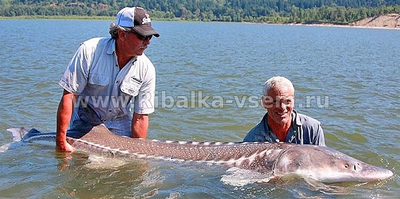
Nile perch
This is another relative of our domestic fish, or rather, perch, familiar to all "sailors". Only the size of the overseas brother is impressive and in awe. As the name implies, this "perch", reaching a length of 1.8 meters and weighing more than 180 kg, lives in the ever-muddy Nile River, and also in the rivers - Niger, Congo, Senegal. Like our perches, the Nile perch has yellow eyes with black dotted pupils. But the coloring of this perch is somewhat different, without stripes, instead of which the sides shine with silver with some bluish tints, which makes this seasoned predator very beautiful.

Alligator garfish
The largest river fish in the world are represented by another species that is really a monster. This is an alligator garfish. The appearance of this monster is almost a copy of the alligator crocodile, at least that's what the fish's head looks like. But, despite such a picturesque and violently aggressive appearance, these fish have never attacked people, in any case, such information has not been received. The size of these inhabitants of the water depths is also not offended. Garfish alligators can weigh up to 140 kilograms with a length of 3 meters.
Arapaima giant
This is a fish that really deserves to be on the list - the largest freshwater fish. Instances 3 meters long and weighing more than 68 kilograms are not uncommon in the waters of the Amazon. Confirmed data speak of arapaima weighing up to 200 kg. This is a swift and furious predator, which manages not only to catch up and swallow fish, but also to get birds and small animals sitting on trees in a jump.

Arapaima can live in the most impassable swamps, where the water is very poor in oxygen. But this cunning fish has adapted to breathe atmospheric air, for which it needs to rise to the surface of the reservoir at certain intervals, which are about 20 minutes. Arapaima giant is protected by very dense and strong scales, but this did not save it from extermination by local native tribes, who from time immemorial hunted this fish for food. Now these fish are protected and are likely to become an object of breeding.
Tiger goliath fish
The largest freshwater fish will be horrified at the appearance of another real monster that will frighten even any predator with the sight of its terrible teeth, since the goliath tiger fish is a giant piranha. In addition to being one of the largest fish and reaching a length of 180 cm with a weight of 50 kilograms, this fish is also the most dangerous among all types of predatory fish.
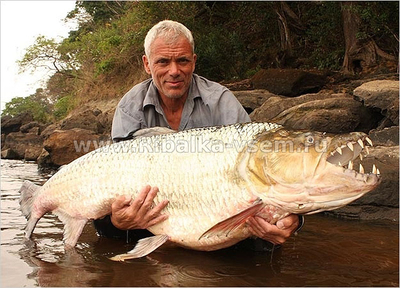
And this danger threatens weak man, and no less bloodthirsty strong crocodile. And the teeth of the goliath fish bite even metal leashes, if the metal for them is not the most durable. In addition to the Congo River, these fish are not found anywhere else.
Will allow you to purchase any goods for fishing at competitive prices!
Popular sections of the site:
It will allow you to understand how all the fish peck, depending on the time of year and month.
The page will tell you about many popular tackle and accessories for fishing.
We describe in detail living, vegetable, artificial and unusual.
In the article you will get acquainted with the main types, as well as tactics for their use.
Learn everything to become a real angler and learn the right choice.
Carp is the common name for freshwater fish of the carp family. They are widely distributed in various water bodies around the world. They prefer quiet, stagnant or slow-flowing waters with a hard clay and slightly silty bottom. Able to grow up to 1.2 meters in length and weigh more than 100 kg. They feed on mollusks, crustaceans, worms and insect larvae. The largest carp caught by a British angler in 2013 weighed 45.59 kg.

Common taimen is a species of large freshwater fish, the largest representative of the salmon family. They live in the fast-flowing coldish rivers of Siberia and in the Amur River basin. Common taimen can grow up to 1.5–2 m long and weigh 60–80 kg. However, most of the mature fish caught averaged 70 to 120 cm in length and weighed 15 to 30 kg. The largest specimen caught, recorded by the International Game Fish Association, weighed 41.95 kg and was 156 cm long. The species is listed in the Red Book.

The common catfish is a large freshwater scaleless bottom fish that lives in deep sections of rivers, deep channels, lakes and reservoirs throughout Europe and Asia. The body length of catfish can reach 5 m, weight - 100 kg. There is a lot of information about giant catfish, reaching 250–300 kg, but there is no documentary evidence of the existence of such catfish. It is a typical predator and feeds on fish, large benthic invertebrates, amphibians, reptiles, waterfowl, small mammals and even relatives. Like pike, catfish is an excellent orderly of reservoirs; it eats sick and weakened fish. Cases of attacks on people are also described.

Nile perch - a species of large freshwater predatory fish living in the basins of the Congo, Nile, Senegal, Niger, as well as in the lakes of Chad, Volta, Turkana and other reservoirs. Found in Lake Maryut in Egypt. Able to grow up to 2 meters in length, and weigh up to 200 kg. However, adults usually reach a length of 121-137 cm. The Nile perch is a predator that dominates in the waters of residence. It feeds mainly on fish, crustaceans and insects. Where food resources are limited, relatives can also be eaten.
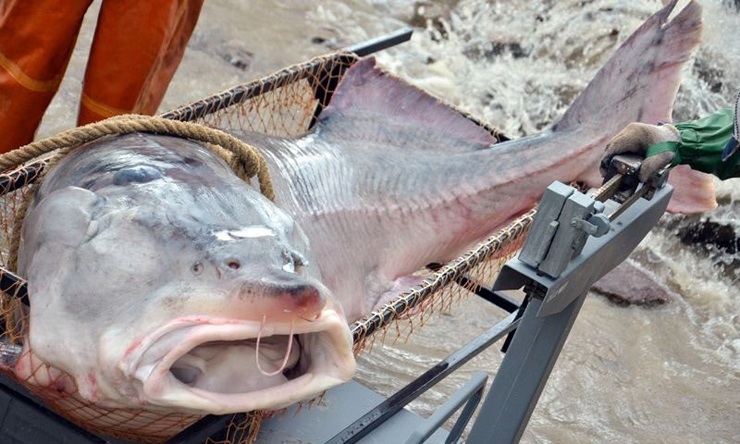
Beluga is a species of fish from the sturgeon family. It lives in the White, Caspian, Azov, Black, Adriatic seas, from where it enters the rivers for spawning. Their body length can reach 5 m, weight - 1000 kg (usually they catch individuals up to 2.5 m and weighing up to 200–300 kg). As an exception, according to unconfirmed reports, there were individuals 9 m long and weighing up to 2 tons, if this information is correct, then the beluga can be considered the largest freshwater fish globe. It feeds mainly on fish, but does not neglect shellfish.

The fifth place in the list of the largest freshwater fish on the planet is occupied by the White sturgeon - a species of fish of the sturgeon family, the largest freshwater fish in North America. It lives at the bottom of slow-moving rivers and bays along the western coast of North America. White sturgeon can grow up to 6.1 m long and weigh 816 kg. It feeds mainly on fish, crustaceans and mollusks.

The Chinese paddlefish or psephur is a freshwater fish that lives only in the Yangtze River, sometimes swims in large lakes and the Yellow Sea. Their body length can exceed 3 meters, weight 300 kilograms. There is information that in the 1950s, fishermen caught a paddlefish 7 meters long and weighing about 500 kg, although the reliability of this story is unconfirmed. Feeds on fish and crustaceans. Its meat and caviar are highly valued in China.

The giant freshwater stingray (Himantura polylepis) is a species of freshwater stingray that lives in the tropical waters of several major rivers in Indochina and Kalimantan. Able to grow up to 1.9 m wide and weigh 600 kg. They feed mainly on crustaceans and mollusks, possibly earthworms. The giant freshwater stingray is not aggressive, although they must be handled with care as their venomous long spike can easily pierce human bone. This species is endangered.
Mississippi cuirass

The Mississippi shell or alligator pike is a species of large freshwater fish found in the lower Mississippi River valley and its tributaries in North and Central America. This is a very fast and strong, but shy fish. According to experts, the Mississippian shell can grow up to 3 m in length and weigh more than 130 kg. In 2011, the largest carapace caught was officially registered, its length was 2.572 m, weight 148 kg. It feeds mainly on fish, small mammals, birds, turtles, etc. There are known cases of attacks on children, fortunately, they never ended fatally. Included in the list of prehistoric fish that were considered extinct.

The giant shilb catfish is the largest endangered freshwater fish. It is found only in the lower reaches of the Mekong River, as well as in the Tonle Sap River and Tonle Sap Lake in Cambodia. Fish of this species can grow up to 3 meters in length and weigh 150–200 kg. They are herbivores - they feed mainly on algae and phytoplankton. The largest specimen caught in 2005 reached a length of 2.7 m and weighed 293 kg, it was he who was recognized as the largest freshwater fish caught by man.
Share on social networks
I present to your attention a list of the 10 largest freshwater fish in the world.
10. Carp
Carp is the common name for freshwater fish of the carp family. They are widely distributed in various water bodies around the world. They prefer quiet, stagnant or slow-flowing waters with a hard clay and slightly silty bottom. Able to grow up to 1.2 meters in length and weigh more than 100 kg. They feed on mollusks, crustaceans, worms and insect larvae. The largest carp caught by a British angler in 2013 weighed 45.59 kg.
9. Common taimen
Common taimen is a species of large freshwater fish, the largest representative of the salmon family. They live in the fast-flowing coldish rivers of Siberia and in the Amur River basin. Common taimen can grow up to 1.5–2 m long and weigh 60–80 kg. However, most of the mature fish caught averaged 70 to 120 cm in length and weighed 15 to 30 kg. The largest specimen caught, recorded by the International Game Fish Association, weighed 41.95 kg and was 156 cm long. The species is listed in the Red Book.
8. Common catfish
The common catfish is a large freshwater scaleless bottom fish that lives in deep sections of rivers, deep channels, lakes and reservoirs throughout Europe and Asia. The body length of catfish can reach 5 m, weight - 100 kg. There is a lot of information about giant catfish, reaching 250–300 kg, but there is no documentary evidence of the existence of such catfish. It is a typical predator and feeds on fish, large benthic invertebrates, amphibians, reptiles, waterfowl, small mammals and even relatives. Like pike, catfish is an excellent orderly of reservoirs; it eats sick and weakened fish. Cases of attacks on people are also described.
7. Nile Perch
The Nile perch is a species of large freshwater predatory fish that lives in the basins of the Congo, Nile, Senegal, Niger rivers, as well as in the lakes of Chad, Volta, Turkana and other reservoirs. Found in Lake Maryut in Egypt. Able to grow up to 2 meters in length, and weigh up to 200 kg. However, adults usually reach a length of 121-137 cm. The Nile perch is a predator that dominates in the waters of residence. It feeds mainly on fish, crustaceans and insects. Where food resources are limited, relatives can also be eaten.
6. Beluga
Beluga is a species of fish from the sturgeon family. It lives in the White, Caspian, Azov, Black, Adriatic seas, from where it enters the rivers for spawning. Their body length can reach 5 m, weight - 1000 kg (usually they catch individuals up to 2.5 m and weighing up to 200–300 kg). As an exception, according to unconfirmed reports, there were individuals 9 m long and weighing up to 2 tons, if this information is correct, then the beluga can be considered the largest freshwater fish in the world. It feeds mainly on fish, but does not neglect shellfish.
5. White sturgeon
The fifth place in the list of the largest freshwater fish on the planet is occupied by the White sturgeon - a species of fish of the sturgeon family, the largest freshwater fish in North America. It lives at the bottom of slow-moving rivers and bays along the western coast of North America. White sturgeon can grow up to 6.1 m long and weigh 816 kg. It feeds mainly on fish, crustaceans and mollusks.
4 Chinese paddlefish
The Chinese paddlefish or psephur is a freshwater fish that lives only in the Yangtze River, sometimes swims in large lakes and the Yellow Sea. Their body length can exceed 3 meters, weight 300 kilograms. There is information that in the 1950s, fishermen caught a paddlefish 7 meters long and weighing about 500 kg, although the reliability of this story is unconfirmed. Feeds on fish and crustaceans. Its meat and caviar are highly valued in China.
3. Giant freshwater stingray
The giant freshwater stingray (Himantura polylepis) is a species of freshwater stingray that lives in the tropical waters of several major rivers in Indochina and Kalimantan. Able to grow up to 1.9 m wide and weigh 600 kg. They feed mainly on crustaceans and mollusks, possibly earthworms. The giant freshwater stingray is not aggressive, although they must be handled with care as their venomous long spike can easily pierce human bone. This species is endangered.
2. Mississippi shell
The Mississippi shell or alligator pike is a species of large freshwater fish found in the lower Mississippi River valley and its tributaries in North and Central America. This is a very fast and strong, but shy fish. According to experts, the Mississippian shell can grow up to 3 m in length and weigh more than 130 kg. In 2011, the largest carapace caught was officially registered, its length was 2.572 m, weight 148 kg. It feeds mainly on fish, small mammals, birds, turtles, etc. There are known cases of attacks on children, fortunately, they never ended fatally. Included in the list of prehistoric fish that were considered extinct.
1. Giant shilbovy catfish
The giant shilb catfish is the largest endangered freshwater fish. It is found only in the lower reaches of the Mekong River, as well as in the Tonle Sap River and Tonle Sap Lake in Cambodia. Fish of this species can grow up to 3 meters in length and weigh 150–200 kg. They are herbivores - they feed mainly on algae and phytoplankton. The largest specimen caught in 2005 reached a length of 2.7 m and weighed 293 kg, it was he who was recognized as the largest freshwater fish caught by man.
The ocean is not the only place where you can find large representatives of different species. Beneath the murky waters of our freshwater rivers and lakes lurk 11 giant freshwater fish.
While most freshwater fish are small to medium in size compared to their counterparts in salt water seas and oceans, there are some that can grow to gigantic sizes. You need to think carefully about whether you are ready to meet these freshwater giants.
Here are 11 freshwater giant fish.
Beluga
This giant fish should not be confused with the beluga (a species of toothed whale), which has nothing to do with the beluga. This fish is included in the IUCN Red Book, is one of the sturgeon species that inhabits the rivers and seas of central Eurasia (Caspian, Black, Azov).
Since the beluga continues to grow throughout its life, it can be called the largest freshwater fish in the world. The largest of these giants reached a length of up to 9.15 meters and weighed more than 2730 kg. Such numbers also make beluga worthy competitors for the title of the largest bony fish in the world by mass.
catfish
This fish is one of the largest freshwater species. Catfish is found in many European rivers and successfully lives and breeds also in lakes. It is practically blind and relies on a highly developed sense of smell and long, sensitive whiskers. They help catfish find dead, sick or injured fish. Rows of sandpaper-like teeth allow the catfish to grab and hold prey before it can crush and swallow it. There are such large catfish that grow up to 3.5 m and weigh up to 300 kg.
Mississippi cuirass
With a double row of large teeth and an alligator-like snout, these carnivorous fish may well be the most feared inhabitants that lurk in the rivers of North America. With a length of up to 3 meters, the Mississippian shell can survive without water for two hours.
Found in the lower Mississippi Basin and in the waters of all the Gulf Coast countries, this terrible fish tends to swim near the surface or among the reeds, where it can lie in wait, lying in wait for prey. Despite its intimidating appearance, the Mississippian shell is passive towards humans.
Arapaima

The list of 11 freshwater giant fish continues with the prehistoric monster - Arapaima. Living in the Amazon, these giant fish are very ancient and large. They are able to grow in length over 3.2 meters. Arapaima are such ancient fish that they are considered living fossils.
These fish are also incredible jumpers, and can jump above the water if they feel threatened. Unfortunately, it is now a very rare species and there are very few records of its size.
Giant freshwater stingray

This intimidating freshwater fish can grow to enormous sizes, weighing over 455kg, the giant freshwater stingray is about 4.6m across.
Found in the rivers of Southeast Asia, it has a very sharp, toothed spike on its tail that can be up to 38 cm long and can easily cause permanent injury.
Unfortunately, like most amazing freshwater species, the giant freshwater stingray is endangered and endemic to Southeast Asia.
paddlefish

These river giants are easily recognizable by the shape of their paddle-like muzzle. Sturgeon paddlefish are harmless filter feeders that use their unusual and large enough mouth to feed on zooplankton.
Only two types of these have survived today. unique fish: The Chinese paddlefish Psephur and the American paddlefish, often referred to simply as the paddlefish. Psephur, who inhabited the Yangtze River, reached 7 m in length. American paddlefish living in Mississippi (once lived in the area) can grow up to 2 meters and weigh about 90 kg.
Carp

All subspecies of carp can grow to a respectable size. Usually found in lakes and ponds with stagnant water, but can successfully exist in rivers. Carp does not have digestive glands, therefore it is distinguished by amazing voracity. It feeds almost continuously throughout the day.
In a nutshell, carps can be described as “powerful centenarians” - there have been cases of catching specimens that were over 40 years old and weighed more than 40 kg.
white sturgeon

The largest freshwater fish in North America is the white sturgeon, which can grow to an incredible 6m in length.
The white sturgeon, which lives along the western coast of North America, is one of those ancient fish that have retained their shape for more than 175 million years. Due to the excessive curiosity of fishermen, some white sturgeon populations are endangered.
Nile perch
![]()
Native to the tropical rivers and lakes of Africa, the Nile perch is Africa's largest freshwater fish. With a giant mouth, the Nile perch reaches 1.8 m in length.
